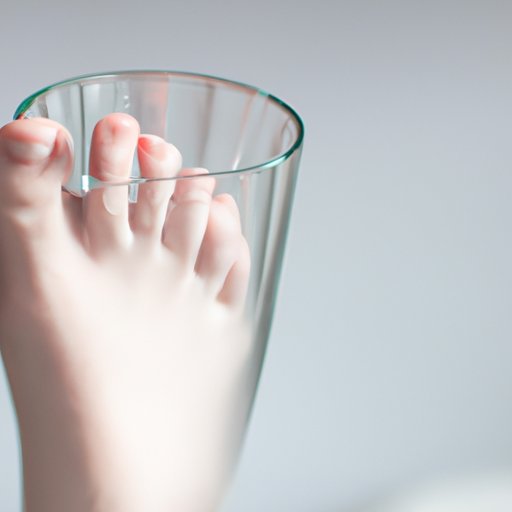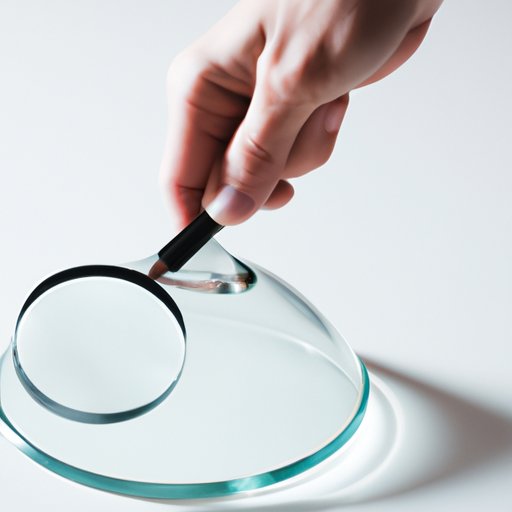
Introduction
Have you ever accidentally stepped on a piece of glass? It’s a painful experience that most of us have had. Unfortunately, sometimes the glass gets stuck in your foot, and you might not realize it. In this article, we will explore what happens if you leave glass in your foot, and provide you with advice on how to remove it safely.
Explanation of the Problem
When a piece of glass is lodged in your foot, it can cause pain, swelling, redness, and difficulty walking. While some smaller pieces of glass will work themselves out naturally, larger pieces or those that go deeper can cause complications if left untreated.
Importance of Addressing the Issue
Leaving glass in your foot can lead to infection, tissue damage, and in some cases, even long-term consequences. It’s important to take steps to remove it as soon as possible to avoid these risks.
Purpose of the Article
In this article, we will provide you with advice on how to remove glass from your foot safely, what complications can arise if left in place, and when to seek medical attention if needed.

The Importance of Removing Glass Promptly
Explanation of Why It’s Important
When glass is embedded in your foot, it provides a breeding ground for bacteria that can lead to infection. In addition, it can cause inflammation and tissue damage if left in for an extended period of time.
Risks of Delaying the Removal
The longer you wait to remove the glass, the higher the risk of complications. You can increase the risk of infection, and the glass can damage your tissues and lead to long-term consequences.
Common Complications if Glass is Left in Your Foot
Infection
When glass is left in your foot, bacteria can build up around the area and cause an infection. Signs of infection include redness, swelling, warmth, and a fever. If the infection is not treated, it can spread to the rest of your body and cause serious complications.
Tissue Damage
If left in for an extended period of time, glass can cause tissue damage to the area around it. It can cause scar tissue and permanent damage if not removed promptly.
Long-term Consequences
In some cases, if glass is left in your foot, you can develop a foreign body granuloma. This is when tissue grows around the foreign object, creating a mass. It can be painful and require surgical removal.
Advice on How to Remove Glass from Your Foot Safely
Steps to Take Before Attempting to Remove It
Before attempting to remove glass from your foot, you should clean the area with soap and warm water. Sterilize the area with rubbing alcohol or hydrogen peroxide. Make sure to use clean and disinfected tools to avoid infection.
Tools to Use
The tools you use to remove the glass depend on the size of the glass and how deep it is. Tweezers are recommended for small and shallow pieces. A sterilized needle or scalpel may be needed for larger and deeper pieces.
Technique to Use
To remove the glass, grasp it gently with tweezers and pull it out of the skin at the same angle that it went in. If using a needle or scalpel, make a small incision and remove the glass with tweezers. Apply antiseptic to the area and cover it with a sterile gauze or bandage.
Steps to Take if You are Unable to Remove Glass from Your Foot
When to Seek Medical Attention
If you are unable to remove the glass or if the area becomes infected, seek medical attention immediately. You should also contact a doctor if the area becomes red, inflamed, or if you develop a fever.
Preparations Before Seeing a Doctor
Before seeing a doctor, clean the area thoroughly and cover it with a sterile bandage. If possible, bring the piece of glass with you to the appointment.
What to Expect During the Removal Process
During the removal process, the doctor will clean the area and numb it with a local anesthetic. They will then remove the glass with tweezers or a needle, and clean the area again. In some cases, stitches may be needed to close the wound.
The Risks of Leaving Glass in Your Foot and How to Prevent It
Causes of the Issue
Some common causes of glass in your foot include walking barefoot, stepping on broken glass, or working in construction jobs.
Preventative Measures
To prevent glass from getting stuck in your foot, wear shoes that cover your feet when walking outside or in a construction zone. If you break any glass at home, make sure to clean it up thoroughly to avoid future mishaps.
How a Doctor Can Assist with the Removal of Glass from Your Foot
The Doctor’s Role
A doctor can assist with the safe removal of glass by providing local anesthesia and using sterile techniques.
Techniques Used by Medical Professionals
Medical professionals use a variety of techniques to remove glass, including tweezers, needles, and scalpels. They may also use imaging techniques like x-rays to locate and remove the glass.
What to Expect During a Medical Procedure
During a medical procedure, the area around the glass will be cleaned and numbed with a local anesthetic. The glass will then be removed using appropriate techniques, and the area will be cleaned again and bandaged.
Conclusion
Recap of Key Points
Leaving glass in your foot can cause infection, tissue damage, and long-term consequences. It’s important to remove the glass as soon as possible and seek medical attention if needed.
Final Advice
If you can’t remove the glass from your foot safely or if the area becomes infected, seek medical attention immediately. Take steps to prevent glass from getting stuck in your foot by wearing protective shoes and cleaning up broken glass thoroughly.
Encouragement to Take Action if Needed
Don’t ignore glass in your foot. Take action promptly to avoid complications and long-term consequences.




